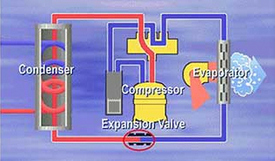How it works. Anatomy of a Geothermal Heat Pump.
You already have a heat pump in your home - your refrigerator. If you put your hand behind it, you'll feel the heat that's being pumped from the inside. A geothermal heat pump works much the same way
It's the same principle that a geothermal heat pump uses to warm your home. Instead of producing heat like a conventional furnace, a geothermal heat pump moves heat from one place to another - from the ground into your home. Geothermal Heating and Cooling Geothermal cooling process The diagram above illustrates the summer geothermal cooling process:
In short, the indoor coil and underground piping cause the refrigerant to change state, absorbing and releasing heat through boiling and condensing. The compressor and expansion valve move the refrigerant through the system by changing the pressure. Need more information on Geothermal heating and cooling… Geothermal is a natural way to tap into the earth’s natural energy to efficiently and economically heat and cool your home. For more information on geothermal heating and cooling contact the experienced geothermal experts at K. Kelly at 920-469-3500 to get all your geothermal questions answered. Back to Geothermal |
|
